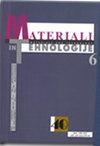DEVELOPMENT OF THE RECYCLING PROCEDURE FOR RAPID ANTIGEN TESTS
IF 0.6
4区 材料科学
Q4 MATERIALS SCIENCE, MULTIDISCIPLINARY
引用次数: 0
Abstract
The article presents the problem of rapid antigen tests when they become mass waste after use. Based on this, the hypothesis was made that rapid antigen tests can be recycled. Rapid antigen tests, which were used in the Covid-19 epidemic to quickly detect infections in the population or to confirm the presence of the Sars-Cov 2 virus in patients, were intended to limit the spread of the epidemic. To confirm the hypothesis of recycling for rapid antigen tests, the LFIA-REC ATP 150 project was prepared, which was selected for co-financing by the Norwegian Fund. Rapid antigen tests consist of a sample and conjugate pad, detectable or nitrocellulose membranes and absorbent pads and a plastic case. The function of the sample pad is to evenly absorb the sample (mucus, blood) and lead it to the conjugate pad with a steady flow. Gold nanoparticles (labels) are deposited on the conjugate pad. The key is that the gold nanoparticles are conjugated with capture molecules capable of binding to potentially present antibodies or virus in the sample. The scope of the research problem thus required the inclusion of various characterization techniques that must be applied to the individual material in the rapid antigen test to subsequently develop an efficient recycling process for the rapid antigen tests. The result of the research presented in this paper represents a newly developed algorithm of characterization techniques, which includes a recommended description of the preparation of samples of key materials from rapid antigen tests. This algorithm successfully achieved the characterization of gold nanoparticles from rapid antigen tests. Based on the developed algorithm, the final part of the project will validate the recycling process of rapid antigen tests, so that they can be recycled, i.e. gold nanoparticles or plastic used in new products. The paper presents the algorithm of characterization techniques with a description of the preparation of material samples from rapid antigen tests.开发快速抗原检测的再循环程序
文章介绍了快速抗原检测仪在使用后成为大量废物的问题。在此基础上,提出了快速抗原检测仪可以循环使用的假设。在科维德-19疫情中,快速抗原检测仪被用来快速检测人群中的感染情况或确认病人体内是否存在萨斯-科维德2病毒,其目的是限制疫情的蔓延。为了证实快速抗原检测的回收利用假设,制定了 LFIA-REC ATP 150 项目,该项目被挪威基金选中共同出资。快速抗原检测由样本垫和结合垫、检测膜或硝化纤维膜、吸收垫和塑料盒组成。样本垫的作用是均匀地吸收样本(粘液、血液),并将其稳定地导入连接垫。纳米金粒子(标签)沉积在共轭垫上。关键是金纳米粒子与捕获分子共轭,能够与样本中可能存在的抗体或病毒结合。因此,研究问题的范围要求纳入各种表征技术,这些技术必须应用于快速抗原检测中的单个材料,以便随后为快速抗原检测开发高效的回收流程。本文介绍的研究成果是一种新开发的表征技术算法,其中包括对快速抗原检测中关键材料样品制备的建议说明。该算法成功实现了对快速抗原测试中金纳米粒子的表征。根据所开发的算法,项目的最后一部分将验证快速抗原检测的回收过程,使其可以回收利用,即在新产品中使用纳米金颗粒或塑料。本文介绍了表征技术的算法,并描述了快速抗原测试材料样本的制备过程。
本文章由计算机程序翻译,如有差异,请以英文原文为准。
求助全文
约1分钟内获得全文
求助全文
来源期刊

Materiali in tehnologije
工程技术-材料科学:综合
CiteScore
1.30
自引率
0.00%
发文量
73
审稿时长
4-8 weeks
期刊介绍:
The journal MATERIALI IN TEHNOLOGIJE/MATERIALS AND TECHNOLOGY is a scientific journal, devoted to original papers and review scientific papers concerned with the areas of fundamental and applied science and technology. Topics of particular interest include metallic materials, inorganic materials, polymers, vacuum technique and lately nanomaterials.
 求助内容:
求助内容: 应助结果提醒方式:
应助结果提醒方式:


